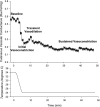Thermal provocation to evaluate microvascular reactivity in human skin
- PMID: 20507974
- PMCID: PMC2963329
- DOI: 10.1152/japplphysiol.00414.2010
Thermal provocation to evaluate microvascular reactivity in human skin
Abstract
With increased interest in predictive medicine, development of a relatively noninvasive technique that can improve prediction of major clinical outcomes has gained considerable attention. Current tests that are the target of critical evaluation, such as flow-mediated vasodilation of the brachial artery and pulse-wave velocity, are specific to the larger conduit vessels. However, evidence is mounting that functional changes in the microcirculation may be an early sign of globalized microvascular dysfunction. Thus development of a test of microvascular reactivity that could be used to evaluate cardiovascular risk or response to treatment is an exciting area of innovation. This mini-review is focused on tests of microvascular reactivity to thermal stimuli in the cutaneous circulation. The skin may prove to be an ideal site for evaluation of microvascular dysfunction due to its ease of access and growing evidence that changes in skin vascular reactivity may precede overt clinical signs of disease. Evaluation of the skin blood flow response to locally applied heat has already demonstrated prognostic utility, and the response to local cooling holds promise in patients in whom cutaneous disorders are present. Whether either of these tests can be used to predict cardiovascular morbidity or mortality in a clinical setting requires further evaluation.
Figures



Similar articles
-
Assessment of endothelial and neurovascular function in human skin microcirculation.Trends Pharmacol Sci. 2013 Jul;34(7):373-84. doi: 10.1016/j.tips.2013.05.007. Epub 2013 Jun 21. Trends Pharmacol Sci. 2013. PMID: 23791036 Review.
-
Microvascular endothelial dysfunction during cardiopulmonary bypass in surgery for correction of cyanotic and acyanotic congenital heart disease.Microvasc Res. 2018 Nov;120:55-58. doi: 10.1016/j.mvr.2018.06.004. Epub 2018 Jun 27. Microvasc Res. 2018. PMID: 29958862
-
Comparison of skin microvascular reactivity with hemostatic markers of endothelial dysfunction and damage in type 2 diabetes.Vasc Health Risk Manag. 2008;4(6):1449-58. doi: 10.2147/vhrm.s4175. Vasc Health Risk Manag. 2008. PMID: 19337558 Free PMC article.
-
Impaired flow-mediated vasodilation in type 2 diabetes: lack of relation to microvascular dysfunction.Microvasc Res. 2008 May;76(1):61-5. doi: 10.1016/j.mvr.2008.03.001. Epub 2008 Mar 20. Microvasc Res. 2008. PMID: 18448131
-
Edward F. Adolph Distinguished Lecture: Skin-deep insights into vascular aging.J Appl Physiol (1985). 2017 Nov 1;123(5):1024-1038. doi: 10.1152/japplphysiol.00589.2017. Epub 2017 Jul 20. J Appl Physiol (1985). 2017. PMID: 28729391 Free PMC article. Review.
Cited by
-
Sensory nerve-mediated and nitric oxide-dependent cutaneous vasodilation in normotensive and prehypertensive non-Hispanic blacks and whites.Am J Physiol Heart Circ Physiol. 2020 Aug 1;319(2):H271-H281. doi: 10.1152/ajpheart.00177.2020. Epub 2020 Jun 19. Am J Physiol Heart Circ Physiol. 2020. PMID: 32559139 Free PMC article.
-
Local thermal control of the human cutaneous circulation.J Appl Physiol (1985). 2010 Oct;109(4):1229-38. doi: 10.1152/japplphysiol.00407.2010. Epub 2010 Jun 3. J Appl Physiol (1985). 2010. PMID: 20522732 Free PMC article. Review.
-
Development of a Non-Invasive Local Heating Load Test to Detect Severe Limb Ischemia Within 200 seconds.Vasc Endovascular Surg. 2023 Jan;57(1):19-25. doi: 10.1177/15385744221120977. Epub 2022 Aug 13. Vasc Endovascular Surg. 2023. PMID: 35968758 Free PMC article.
-
Short-term exercise-heat acclimation enhances skin vasodilation but not hyperthermic hyperpnea in humans exercising in a hot environment.Eur J Appl Physiol. 2012 Jan;112(1):295-307. doi: 10.1007/s00421-011-1980-6. Epub 2011 May 6. Eur J Appl Physiol. 2012. PMID: 21547423
-
Intradermal administration of ATP augments methacholine-induced cutaneous vasodilation but not sweating in young males and females.Am J Physiol Regul Integr Comp Physiol. 2015 Oct 15;309(8):R912-9. doi: 10.1152/ajpregu.00261.2015. Epub 2015 Aug 19. Am J Physiol Regul Integr Comp Physiol. 2015. PMID: 26290105 Free PMC article.
References
-
- Abularrage CJ, Sidawy AN, Aidinian G, Singh N, Weiswasser JM, Arora S. Evaluation of the microcirculation in vascular disease. J Vasc Surg 42: 574–581, 2005 - PubMed
-
- Agarwal SC, Allen J, Murray A, Purcell IF. Comparative reproducibility of dermal microvascular blood flow changes in response to acetylcholine iontophoresis, hyperthermia and reactive hyperaemia. Physiol Meas 31: 1–11, 2010 - PubMed
-
- Anderson TJ, Uehata A, Gerhard MD, Meredith IT, Knab S, Delagrange D, Lieberman EH, Ganz P, Creager MA, Yeung AC. Close relation of endothelial function in the human coronary and peripheral circulations. J Am Coll Cardiol 26: 1235–1241, 1995 - PubMed
-
- Arildsson M, Asker CL, Salerud EG, Stromberg T. Skin capillary appearance and skin microvascular perfusion due to topical application of analgesia cream. Microvasc Res 59: 14–23, 2000 - PubMed
-
- Bailey SR, Eid AH, Mitra S, Flavahan S, Flavahan NA. Rho kinase mediates cold-induced constriction of cutaneous arteries: role of alpha2C-adrenoceptor translocation. Circ Res 94: 1367–1374, 2004 - PubMed
Publication types
MeSH terms
Grants and funding
LinkOut - more resources
Full Text Sources
Medical

